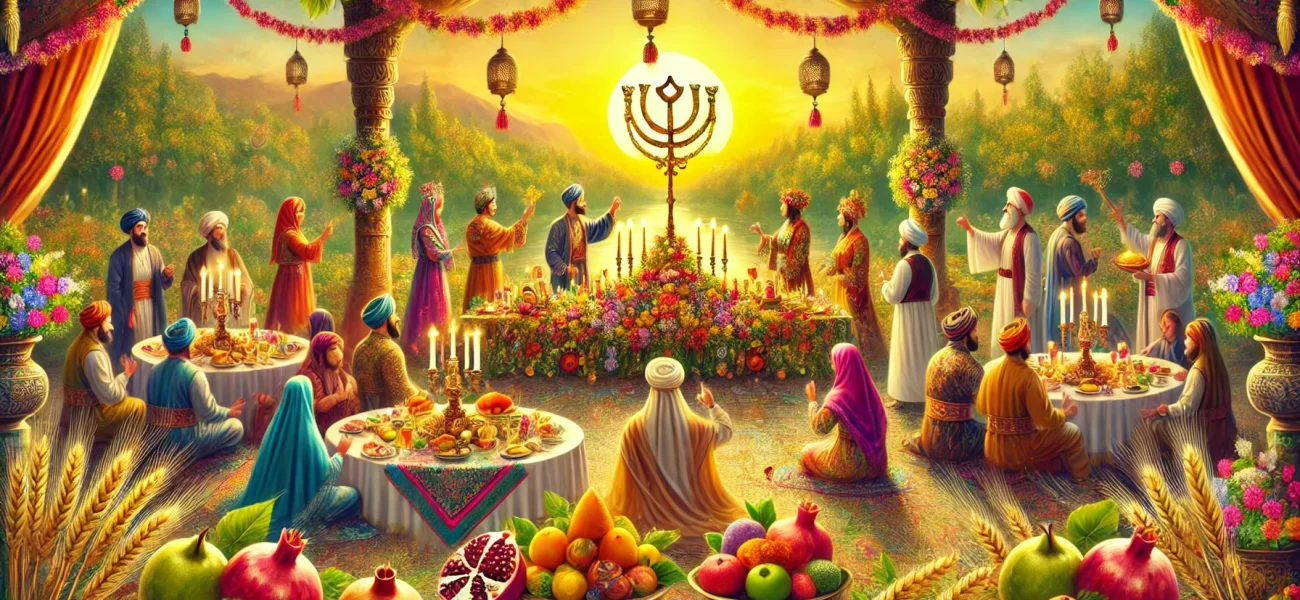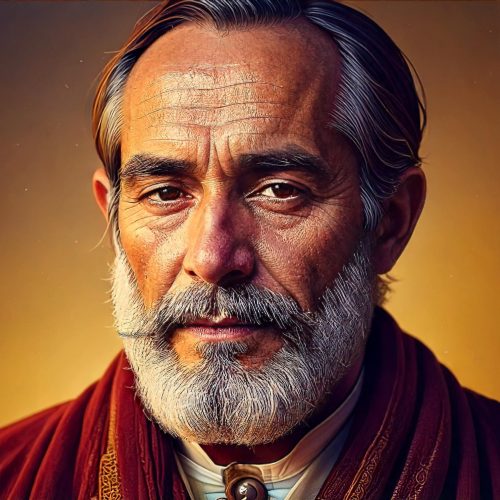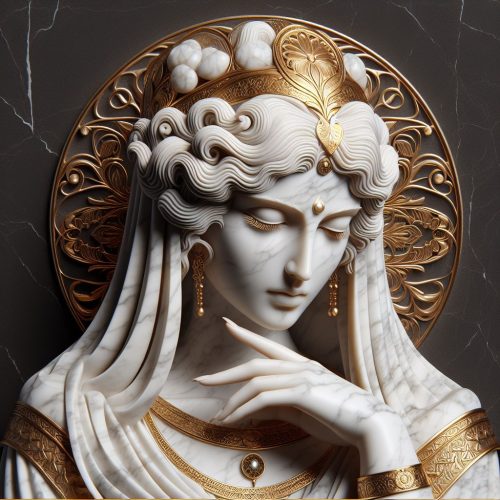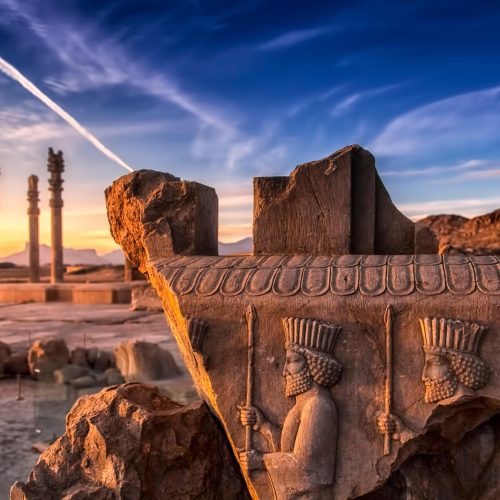As I sit to write these words, the autumn winds gently sway the last golden leaves on the branches of our ancient trees, and a nostalgic melody sweeps through my heart. The air is crisp with the scent of earth, a scent that takes me back to the origins of an ancient celebration, a celebration that sings of unity, love, and the divine balance that holds the universe together. This is Mehregan—a festival that spans millennia and whispers to the deepest chambers of the Iranian soul. For us Iranians, Mehregan is more than just a day marked on the calendar. It is an echo from the past, a timeless ritual that binds us to our ancestors, to nature, and to the ever-present divine force of Mehr—the lord of light, love, and covenant.
It is said that the festival of Mehregan stretches back to the days when the Achaemenid kings themselves honored the sacred figure of Mithra—the Yazata who governs friendship, affection, and the sacred contracts between men and gods. And while our world today may have changed beyond recognition since those distant days, Mehregan’s message remains as luminous and eternal as the very sun that bathes the festival in its golden light.
The Mythic Roots of Mehregan: Reverence for Mehr
Before the birth of civilizations and the rise of empires, the early peoples of Iran dwelled in communion with the forces of nature, shaping their beliefs around the rhythms of the seasons and the mysteries of the heavens. In those ancient days, Mithra—whom we call Mehr in Persian—was not just a deity; Mehr was an idea, a profound cosmic force that held the world in harmonious balance.
Mehr is the guardian of light, but not just any light—the light of the sun, yes, but also the light within the human heart. Mehr is the spirit of friendship and truth, the protector of promises, and the power that forges bonds between individuals, societies, and even nations. Mehr is the divine mediator, standing between humanity and the gods, ensuring that every word spoken in faith is upheld with honor.
And so, it is only fitting that we celebrate Mehregan, or Jashn-e Mehr, when the season of light gives way to the darker days of autumn. In this delicate moment of balance, when day and night hang in perfect symmetry, the festival of Mehregan invites us to pause, reflect, and celebrate all that Mehr represents—the unity between human hearts, the light of affection, and the sacredness of truth.
Mehregan Through the Ages: An Unbroken Chain of Celebration
The origins of Mehregan are lost to the mists of time, woven into the very fabric of Zoroastrianism, the ancient faith of our forefathers. While Nowruz, the vernal celebration of the new year, celebrates the triumph of life and renewal, Mehregan is its autumnal counterpart, marking the completion of the summer harvest and the preparation for the coming winter. In many ways, Mehregan can be seen as the festival of thanksgiving—a time to honor the earth’s bounty, to rejoice in the community that sustains us, and to reflect on the ties that bind us to one another.
Under the Achaemenids, Mehregan became a major state festival. The king himself would don a purple robe, a color that in ancient Iran symbolized royalty and divine blessing. His crown, adorned with the emblem of Mehr, would shimmer in the sunlight as courtiers and citizens gathered to offer their respects. It is said that on Mehregan, no one—not even the king—was above the law of truth and justice, for Mehr’s festival was a time to reaffirm one’s commitment to honesty, righteousness, and the fulfillment of sacred obligations.
During the rule of the Sassanian dynasty, Zoroastrianism flourished as the state religion, and the worship of Mithra became even more central to the spiritual life of the empire. The priests of the Magi would lead elaborate ceremonies in fire temples, where the sacred fire, representing the eternal flame of truth and purity, was kept burning in honor of Mehr. It was during this time that Mehregan became codified as a festival of cosmic significance, celebrated with prayers, feasts, music, and the exchange of gifts.
I remember hearing stories of how the people would gather in white robes, a symbol of purity, to offer thanks for the harvest and pray for protection through the coming winter. There would be lavish banquets laid out, with fruits, nuts, pomegranates, and grapes—foods that symbolize fertility and abundance—adorning the tables. And amidst all this, there was the fire, always the fire, symbolizing the light of Mehr, guiding us through the darkness.
If there is one symbol that connects the ancient festival of Mehregan with the present, it is the fire. Fire, in the Zoroastrian faith, is not merely a natural phenomenon. It is the material representation of Asha, the divine order of the universe, and of Ahura Mazda’s truth. In Mehregan, fire plays a central role, lighting the way for Mehr’s divine influence.
As I reflect on my own experiences of Mehregan, I am always struck by the sacred moment when the fire is lit. The glow of the flames, the way they flicker and dance in the cool autumn air, is a reminder of the eternal struggle between light and dark. To stand before that flame is to feel a connection with our ancestors, those ancient Iranians who kindled the same sacred fires in their villages and temples. Even today, Mehregan calls us to gather around the flame—to look into its depths and contemplate the deeper meanings of life.
During the festivities, the fire burns brightly, symbolizing Mehr’s eternal light, which dispels the shadows of deceit, hatred, and betrayal. As the fire crackles and warms the evening air, we are reminded of the enduring power of friendship and love, of promises kept and contracts honored.
The Rituals of Mehregan: A Time of Unity and Reflection
One cannot speak of Mehregan without speaking of its rituals, for they are the heartbeat of the festival, the living thread that connects us to the divine and to each other. These rituals have evolved over the centuries, yet they remain deeply rooted in the celebration’s original purpose—to honor the Yazata Mehr and renew our commitment to the principles of light, truth, and love.
As a child, I recall the excitement that filled our home in the days leading up to Mehregan. The air was charged with anticipation, as if the very atmosphere was pregnant with the promise of renewal. My mother would prepare the house, cleaning every corner, for the festival demanded purity—not just of the body, but of the heart and mind. The sofreh, a ceremonial cloth, was laid out, and on it were placed the sacred objects that would be part of our Mehregan prayers.
I still remember the objects that adorned our sofreh Mehregan:
- A mirror to reflect the light of Mehr and remind us of self-reflection and truth.
- A brazier of fire, its flames dancing joyfully as a reminder of the eternal light that guides us.
- A bowl of water with floating marigolds, symbolizing the purity and vitality of life.
- A pomegranate, split open to reveal its ruby-red seeds, a symbol of fertility, abundance, and the sweetness of love.
- Sprigs of basil and mint, their fresh scent filling the air with the promise of health and renewal.
- Coins, to symbolize prosperity and good fortune.
We would gather around the sofreh, and the head of the family would lead the prayers, offering thanks to Mehr for the blessings we had received and asking for protection in the months to come. As we recited the ancient prayers, I could feel the presence of my ancestors in the room with us, their spirits joining in our celebration, reminding us that Mehregan was not just a festival of the present but a bridge to the past, a moment when the veil between worlds seemed thin and permeable.
The culmination of the Mehregan rituals was always the offering of wine—the sacred drink of Mithra. As the cup was passed around, each of us would take a sip, symbolically sharing in the divine bond of friendship and unity that Mehr bestows upon all who honor him. Even as a child, I understood the profundity of this moment, the way in which the simple act of drinking together was an affirmation of our connection to each other and to the cosmic order.
Mehregan in Modern Iran: A Resilient Tradition
Though the official recognition of Mehregan may have waned in the centuries since the Islamic conquest, the festival has never disappeared from the hearts of the Iranian people. I have always believed that Mehregan’s endurance speaks to its deep spiritual resonance. Even as modern Iran has changed and transformed, the spirit of Mehregan continues to shine through, finding expression in family gatherings, community events, and even in the quiet moments of personal reflection.
In some rural areas of Iran, especially in Yazd and Kerman, where the Zoroastrian faith has been preserved, Mehregan is still celebrated with great fervor. The fire temples come alive with music, prayer, and joyous feasting. But beyond the boundaries of religion, Mehregan has transcended its origins to become a broader celebration of Iranian culture and identity. It is a reminder that the values of love, friendship, and truth are universal, and that they remain as vital today as they were in the days of our ancestors.
In modern-day Tehran, Isfahan, and Shiraz, one can see how Mehregan has evolved, weaving itself into the fabric of everyday life. People might not always gather around the sofreh as they once did, but the spirit of the festival lives on in the gatherings of friends and family, in the sharing of food and stories, in the laughter that fills the autumn air. Mehregan, like Mehr itself, has found ways to endure, to adapt, to remain relevant in a rapidly changing world.
Mehregan’s Message for the World: Love and Light in Dark Times
As I reflect on Mehregan in today’s world, I am struck by how desperately we need its message. We live in a time when divisions seem to multiply, when darkness too often overshadows light. And yet, the festival of Mehregan reminds us that light always returns, that love and friendship have the power to overcome hatred and discord.
In this time of global uncertainty, Mehregan calls out to us with its ancient wisdom, urging us to rediscover the bonds that unite us as human beings. Mehr teaches us that true power lies not in dominance or control but in the sacred act of giving, in the light we bring into each other’s lives. The rituals of Mehregan—whether we practice them in their traditional form or find new ways to express them—are a reminder of the enduring power of love, trust, and community.
As I sit by the flickering flame of my own hearth, watching the shadows lengthen with the setting sun, I am filled with a sense of peace. Mehregan is not just a festival of the past; it is a living, breathing celebration of the values that sustain us. In honoring Mehr, we honor each other. We honor the light within ourselves and the light we share with the world.
And so, as Mehregan approaches this year, I invite you to pause and reflect on the love that binds us all. Light a candle, share a meal with a friend, speak a word of truth. In these simple acts, we keep the spirit of Mehregan alive. Mehr’s light, after all, is not confined to one season or one people. It is the eternal flame that burns within all of us, waiting to be rekindled with each new dawn.
May this Mehregan bring you peace, love, and the unbreakable bond of friendship. Mehr watches over us all, guiding us through the seasons of life with his radiant light.




